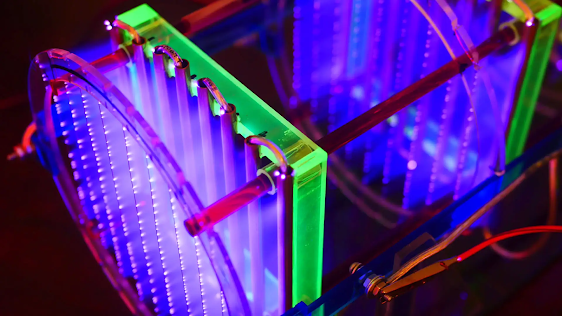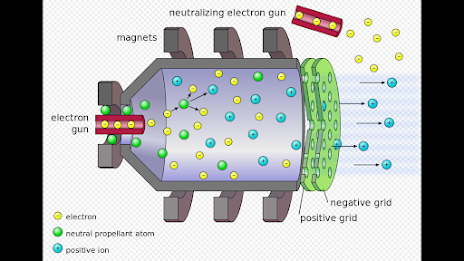IONIC THRUSTERS
Do
you know the majority of mass of a spacecraft at the time of launch is not of
the satellite but of the propellent or the fuel which is used to lift it. What
if we would be able to minimize this weight of fuel . Can we try for
electricity ?
Electric propulsion systems are
becoming more popular due to their efficiency and ability to minimise the
quantity of fuel required. In this blog we will look at one of the promising
technology in the field of electric thrusters. The ion thruster is one sort of
electric propulsion technology. In this we will look at how ion thrusters
function, as well as their advantages, disadvantages, and uses.
Let’s
start with an ‘atom’.. Atoms are mainly made up of three subatomic particles:
neutrons, protons, and electrons. Neutrons have a large mass but no electric
charge, whereas protons are positive and electrons are negative. Different
elements' atoms contain varying proportions of these particles, and an atom
remains in neutral state until number of protons equals the number of
electrons.
Under
normal circumstances, ions that have distinct charges would come into contact
with one other, attracting each other if their electric charges were of
opposing signs and resulting in new molecules with differing characteristics.
nevertheless, under some circumstances, such as high temperatures, intense
electromagnetic fields, or the occurrence of microwaves, ions and electrons can
remain separated, allowing them to operate as electrical conductors. This
condition of matter is referred to as plasma.
Let's
display a look at the parts of an ion thruster now. The initial component is a
container with an open and closed end, with an inlet at the closed end for
introducing a gas such as xenon. Under normal conditions, xenon is a noble gas
that appears as individual atoms having a neutral charge. It does not respond
quickly with other elements, making it simple to manage and store. More
crucially, it is an element with a high atomic mass, which is critical for the
propellant's action.
An
electron gun, commonly referred to as a hollow cathode, is the following
element. It is made out of a tube with a hole in the middle, which contains a
material such as tungsten coated with barium oxide and surrounded by a
resistor. The premise of its operation is that heating the resistance heats the
material within, which begins to emit electrons due to a process known as
thermionic emission. A little amount of xenon is then fed into the tube from
the back, creating the ideal condition for the formation of plasma. When electrons
clash with xenon atoms, they lose one of their electrons and transform into
positively charged xenon ions.
(Source: https://www.nasa.gov/centers/glenn/technology/Ion_Propulsion1.html )
We
now have a plasma volume primarily made up of electrons, and because xenon is
still being fed from the back, it will be driven out through the hole. A
positively charged cover with a dual purpose is added to facilitate this
process. It does two things: first, it directs electrons into the orifice, and
second, it stops other particles from accessing the region where the plasma is
formed and interfering with its operation.
Ion
thrusters bring multiple kinds of advantages, including high specific impulse,
high efficiency, and limited fuel consumption. They do, however, have
significant limitations, such as limited thrust, making them unsuitable for
high-thrust applications. Ion thrusters, on the other hand, are widely employed
in a variety of applications, including satellite propulsion, interplanetary
flight, and deep space research.
(source: https://www.nasa.gov/feature/glenn/2020/the-propulsion-we-re-supplying-it-s-electrifying)
To
summarise, ion thrusters are an effective and dependable source of propulsion
in space exploration. Understanding the concepts underlying plasma formation
and the components of an ion thruster allows us to grasp its benefits, limits,
and numerous uses in current space flight.
Credits: Vijaysingh Rajput (Team TechTuesday)
References:
https://en.wikipedia.org/wiki/Ion_thruster
https://www.nasa.gov/centers/glenn/about/fs21grc.html
NOTE: -
This blog is meant for educational purposes only. The information provided in this article is not investment advice. We do not own any Copyrights related to images and information; all the rights go to their respective owners. The sole purpose of this blog is to Educate, Inspire, Empower and to create awareness in the viewers. The usage is non-commercial (Not for Profit) and we do not make any money from it.
Write your feedback here:
https://forms.gle/C3ybXMPPUaJBgP618
FOLLOW US ON:-
INSTAGRAM:
https://bit.ly/coep_blogs_insta
LINKEDIN:
https://bit.ly/coep_blogs_linkedIn
YOUTUBE:-
https://bit.ly/Coep_blogs_YouTube






Comments
Post a Comment